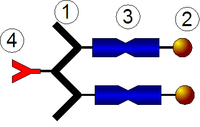
Photo from wikipedia
It is an active research field to develop fiber-shaped smart materials for biomedical applications. Here we report the development of the multifunctional core-shell hybrid microfibers with excellent mechanical and electrical… Click to show full abstract
It is an active research field to develop fiber-shaped smart materials for biomedical applications. Here we report the development of the multifunctional core-shell hybrid microfibers with excellent mechanical and electrical performance as a new smart biomaterial. The microfibers were synthesized using a combination of co-axial spinning with a microfluidic device and subsequent dip-coating, containing a hydrogel core of bacterial cellulose (BC) and a conductive polymer shell layer of poly(3,4-ethylenedioxythiophene) (PEDOT). The hybrid microfibers were featured with a well-controlled microscopic morphology, exhibiting enhanced mechanic properties. A model drug, diclofenac sodium, can be loaded in the core layer of the microfibers in situ during the process of synthesis. Our experiments suggested that the releasing behaviors of the drug molecules from the microfibers were enhanced by external electrical stimulation. Interestingly, we demonstrated an excellent biocompatibility and electroactivity of the hybrid microfibers for PC12 cell culture, thus promising a flexible template for the reconstruction of electrically-responsive tissues mimicking muscle fibers or nerve networks. STATEMENT OF SIGNIFICANCE Fiber-shaped biomaterials are useful in creating various functional objects from one dimensional to three-dimensional. The fabrication of microfibers with integrated physicochemical properties and bio-performance has drawn an increasing attention on researchers from chemical to biomedical. This study combined biocompatible bacterial cellulose with electroconductive poly(3,4-ethylenedioxythiophene) and further reduced them to a highly electroactive BC/PEDOT core-shell microfiber electrode for electrochemical actuator design. The result showed that the microfibers were well fabricated and the release of drugs from the microfibers was enhanced and could be controlled under electrical stimulation externally. Considering the excellent biocompatibility and electroactive toward PC12 cells, these microfibers may find use as templates for the reconstruction of fiber-shaped functional tissues that mimic muscle fibers, blood vessels or nerve networks in vivo.
Journal Title: Acta biomaterialia
Year Published: 2017
Link to full text (if available)
Share on Social Media: Sign Up to like & get
recommendations!